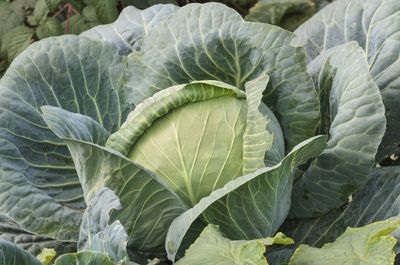First imported to the U.S. in 1824, Brunswick cabbage history says all cole crops were exported under the Brunswick name at that time. The German heirloom, a large drumhead, is becoming rare as winter cabbage growing decreases. For many years it was a favorite for making sauerkraut. It is a shame for this specimen to face extinction. Let’s learn more about growing this cabbage plant.
When to Plant Brunswick Cabbage
You may plant Brunswick cabbage in winter or spring, as well as fall. Much of your planting decision depends on your location. This large head cabbage needs soil temperatures of 45 degrees F. (7 C.). If air temperatures are lower than this but above freezing for most hours, there are alternatives to keep the soil warm. A layer of mulch or of plastic, or both, keeps the soil warmer for the roots. This can be valuable in colder winter climates. Heads of Brunswick cabbage continue growing unless temperatures reach freezing and remain. This specimen takes 90 days to reach maturity, so calculate accordingly in your area. Cold and frost give the Brunswick heads a sweeter flavor. You may start Brunswick cabbage from seed to hasten your late winter planting. Sprout seeds indoors and begin gradually acclimating them to the outdoor cold six weeks before your average last freezing date. Grow seeds to 2 inches (5 cm.) with a few sets of leaves before planting into the ground.
How to Grow Brunswick Cabbage
Plant Brunswick cabbage in a full sun area in rows, trenches, or containers. Brunswick cabbage growing is most successful when planted where lots of sun is available. More than six hours daily will likely increase the size of your final heads. Growing in a large container allows more control of the root system, especially if you have weed issues in the garden or if your mulch is sometimes disturbed. Practice good sanitation, keeping the garden free of debris and weeds. Cabbage loopers, cabbageworms, Diamondback moth caterpillars, along with the typical aphids and other pests will love to settle in on your plants. Check the inside of the bud if you begin seeing holes in leaves or thin strips chewed into leaves. You might also see holes in the heads. You can treat with insecticidal soap or neem oil, spraying inside buds and on the underside of leaves as well. Keep an eye on your plants before turning to something stronger. Pests can cause plant distortion and even death. Some suggest using row covers so that the moths can’t lay their eggs on the plants. Planting nasturtiums throughout the bed will often trap the aphids that bother new growth. If you have pest problems that you can’t seem to control, contact your local extension office for free advice pertinent to your area.
